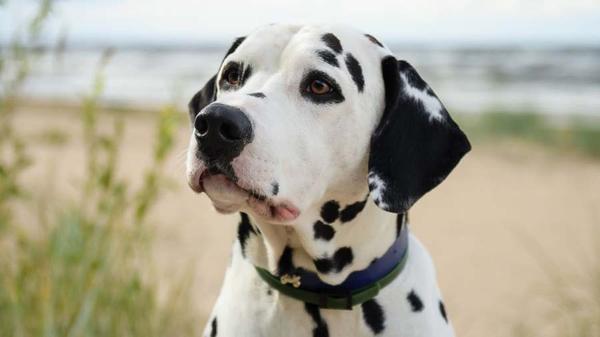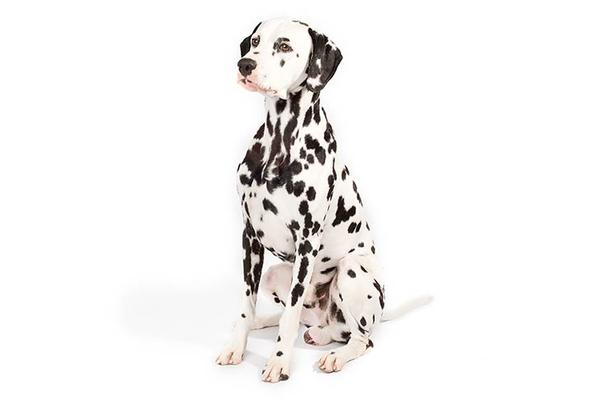Dalmatian
also known as Firehouse Dog, Spotted Coach Dog, Plum Pudding Dog, Carriage Dog, Dally, Dal

 History
History
The Dalmatian is a distinctive and elegant breed of dog that is known for its unique spotted coat and friendly, outgoing personality. This breed has a rich history that dates back to at least the 18th century, and it has been used for a variety of purposes over the years, including hunting, herding, and serving as a coach dog.
The origins of the Dalmatian are somewhat shrouded in mystery, with some historians believing that the breed originated in Egypt and was brought to Europe by Roman soldiers. Others believe that the Dalmatian is a descendant of the spotted breeds of Asia, such as the Dalmatian, which was brought to Europe by traders. Regardless of its origins, the Dalmatian has been a popular breed in Europe for centuries, with the first written records of the breed dating back to the 18th century.
The breed gets its name from the region of Dalmatia, which is located on the eastern coast of the Adriatic Sea in Croatia. It's believed that the Dalmatian originated in this region and was used as a general-purpose hunting and herding dog.
The breed was popularized in the 18th century and were used as carriage dogs. They would run along side the carriages, protecting the horses and the passengers from stray dogs and other animals. The breed is also known for being a great companion dog, as well as participating in various activities such as agility, obedience, and tracking trials.
The Dalmatian was officially recognized as a breed by the Kennel Club (UK) in 1882, and later by the American Kennel Club (AKC) in 1888. The breed was also recognized by many other kennel clubs and organizations around the world, including the Australian National Kennel Council (ANKC) in 1903 and the Canadian Kennel Club (CKC) in 1890.
There are several historic figures associated with the Dalmatian breed. For example, in the late 19th century, the Prince of Wales, who later became King Edward VII, owned a Dalmatian named Nero. Additionally, in the early 20th century, the Dalmatian became the mascot of the American Fire Department, and the breed is still often associated with firehouses to this day.
The Dalmatian has been depicted in various art and literature, including the novel "The Hundred and One Dalmatians" by Dodie Smith which was published in 1956, and the Disney movie "101 Dalmatians" which was released in 1961 and is based on the novel. The story of the novel and the movie is about a litter of 101 Dalmatian puppies who are kidnapped by the villainous Cruella de Vil, who wants to make a fur coat out of their spots. The novel and the movie were hugely popular and helped to cement the Dalmatian's place in popular culture as a beloved and iconic breed. The Dalmatian's popularity surged after the release of the movie.
Breed Information
Is Dalmatian a purebred?
Purebred
What were Dalmatians originally used for?
carriage dog
How Long Do Dalmatians Live? What is average life expectancy for a Dalmatian? How long can Dalmatians live?
12-14 years
The average Dalmatian lifespan is somewhere between 12-14 years, provided they aren't beset by any exceptional health issues or injuries.
Dalmatian Height & Weight
How big is a full grown Dalmatian?

| Height | ||||
|---|---|---|---|---|
| Average | 6 months | 12 months | 18 months | |
| Male | 19-23 inches (48.3 - 58.4 cm) | 15.5 inches (39.4 cm) | 21.0 inches (53.3 cm) | 21.0 inches (53.3 cm) |
| Female | 19-23 inches (48.3 - 58.4 cm) | 15.5 inches (39.4 cm) | 21.0 inches (53.3 cm) | 21.0 inches (53.3 cm) |
| Weight | ||||
|---|---|---|---|---|
| Average | 6 months | 12 months | 18 months | |
| Male | 55-70 pounds (25 - 32 kg) | 30.0 pounds (14 kg) | 52.5 pounds (24 kg) | 62.5 pounds (28 kg) |
| Female | 40-55 pounds (18 - 25 kg) | 22.5 pounds (10 kg) | 37.5 pounds (17 kg) | 47.5 pounds (22 kg) |
Do Dalmatians get fat easily?
![]()
![]()
![]()
![]()
![]()
The Dalmatian is a breed that has an average to high tendency to gain weight if their weight is not closely monitored. It is important to maintain a balance between exercise and food intake to keep them at a healthy weight. This can be achieved by scheduling at least one daily walk and engaging in regular playtime with them.
Are Dalmatians Hypoallergenic?
No
Unfortunately, the Dalmatian is not hypoallergenic, making it not a good choice for a dog lover who suffers from pet allergies.
What is a Dalmatian personality? What are Dalmatian dogs best known for?
Active
Friendly
Outgoing
Sensitive
Energetic
Intelligent
Playful
Are Dalmatians heavy shedders? How Much Does a Dalmatian Shed?
![]()
![]()
![]()
![]()
![]()
Dalmatian dogs are extremely heavy shedders, they will lose a large amount of hair each year. To decrease the amount of shedding, you can regularly brush your Dalmatian.
What is the watchdog ability of a Dalmatian dog?
![]()
![]()
![]()
![]()
![]()
The Dalmatian dogs are average watchdogs. If they sense something different, this breed will alert their owner.
Breed History
Where do Dalmatians come from?
Mediterranean
What are Dalmatians descended from?
great dane, pointer
What organizations or kennel clubs recognize/register the Dalmatian breed?
American Canine Registry
American Kennel Club
America's Pet Registry
Canadian Kennel Club
Dog Registry of America Inc.
Federation Cynologique Internationale
Kennel Club of Great Britain
North American Purebred Registry, Inc.
American Canine Association, Inc.
Australian National Kennel Council
Continental Kennel Club
National Kennel Club
New Zealand Kennel Club
United Kennel Club
When were Dalmatians first bred? How old is the Dalmatian breed?
ancient times
What Breed Group is a Dalmatian?
Non Sporting (AKC:1888)
Companion Breeds (UKC)

Dalmatian Appearance
What color are Dalmatian eyes?
Brown
What color can Dalmatian nose be naturally?
Black
Brown
What color can Dalmatian coat be naturally?
Pied
Black
Brown
White
How long is a Dalmatians coat?
![]()
![]()
![]()
![]()
![]()
The coat of a Dalmatian dog ranges in length from short to medium.
How Dense Is The Dalmatian Coat?
![]()
![]()
![]()
![]()
![]()
What is the texture of the hair of a Dalmatian?
Straight
How many puppies can a Dalmatian have in a litter? How many puppies can a Dalmatian have in her first litter?
12-14 puppies per pregnancy
A Dalmatian can have a litter of 12-14 puppies on average. However, it's worth noting that the size of the litters can vary greatly. Factors that can influence litter size include the health of the mother, breeding history, and genetics.
![]()
![]()
![]()
![]()
![]()
Dalmatians are known for their adaptability and versatility, they are capable of adapting well to a wide range of lifestyle changes and living environments. They are a highly adaptable breed, and make great companions for families and individuals of all lifestyles.

Dalmatian Health Issues
Do Dalmatians have a lot of health problems?
![]()
![]()
![]()
![]()
![]()
The Dalmatian breed is commonly healthy with low vet costs, regular check-ups may not be as necessary but it's important to keep an eye on their health and have them checked by a veterinarian when needed.
What are the major health concerns to be aware of when owning a Dalmatian?
Deafness
Urolithiasis
What are the less significant issues to keep in mind when it comes to Dalmatians?
Demodectic Mange
Cataracts
Laryngeal Paralysis
Dalmatian Bronzing Syndrome
Microphthalmia
What are the occasional tests recommended for Dalmatian breed?
Hearing
Blood And Urine Protein Screens
Skin Scraping
X-Rays
Eye Examination
Physical Examination
Throat

Dalmatian Needs and Activities
Do Dalmatians have a lot of energy?
![]()
![]()
![]()
![]()
![]()
Dalmatians are high-energy dogs, thus an active lifestyle suits them well.
Do Dalmatians need socialization? How social are Dalmatians?
![]()
![]()
![]()
![]()
![]()
Dalmatian have very high social needs. These needs include regular mental and physical stimulation, a job or purpose, and companionship. They thrive in environments where they have a lot of interaction with humans and other dogs.
How much exercise should Dalmatians get?
![]()
![]()
![]()
![]()
![]()
The Dalmatian needs a high level of physical activity to maintain a healthy lifestyle. They also make great companions for people who lead an active lifestyle and enjoy running, hiking or other outdoor activities. These breeds are not suitable for people with sedentary lifestyle or those who live in small apartments
How much sleep should a Dalmatian have? Do Dalmatians sleep a lot?
![]()
![]()
![]()
![]()
![]()
Dalmatians are active dogs that don't require as much sleep as other breeds. However, they still need enough sleep to stay healthy.
Does a Dalmatian drool a lot?
![]()
![]()
![]()
![]()
![]()
The Dalmatian is a breed of dog that is characterized by its minimal drooling, making it an ideal choice for people who dislike drool marks on their clothing.
How much does it bark?
![]()
![]()
![]()
![]()
![]()
Dalmatians tend to bark moderately, they bark when necessary, such as to alert their owner or to communicate something. They may also bark due to certain triggers like fear, alarm, boredom, greeting, separation anxiety and compulsive barking.
Do Dalmatians exhibit aggressive behavior to safeguard their home and territory? Do they possess a natural tendency to guard?
![]()
![]()
![]()
![]()
![]()
Dalmatian dogs are known for being average at defending. They possess the capability to defend their territory or owners, but it is not their primary trait. They are not the best choice for guard dogs
Are Dalmatians mouthy?
![]()
![]()
![]()
![]()
![]()
What is the likelihood of a Dalmatian running away? Do they have a tendency to explore or wander frequently?
![]()
![]()
![]()
![]()
![]()
Do Dalmatian dogs have a high prey drive?
![]()
![]()
![]()
![]()
![]()
What do Dalmatians enjoy doing? How do I keep my Dalmatian busy?
Walk, Play, Sniffing, Walking, Exploring, Bird watching, His walk, Pets, Run, Tug-of-war, Chase, Hide & Seek, Fetch
What is the energy level of a Dalmatian? How much energy does a Dalmatian have?
High
Dalmatians are high-energy dogs. They need mental as well as physical exercise. These dogs require a lot of your involvement and without it they can, and will, become problematic dogs.
![]()
![]()
![]()
![]()
![]()
How far should a Dalmatian walk each week? How many miles should a Dalmatian walk every week?
14 miles / week
There's really no limit to how far you walk your dog as long as they're comfortable. For Dalmatian, it's at least 14 miles / week. Just remember to build distance and stamina gradually over time.
How much a Dalmatian should exercise a day? How much activity does a Dalmatian need?
90 minutes
In general most Dalmatians usually need at least 90 minutes of exercise daily. This can be spread across the day and include all sorts of high-energy activities, like walking, running and playing.
What level of grooming should be provided for a Dalmatian?
![]()
![]()
![]()
![]()
![]()
The Dalmatian is a breed of dog that does not require extensive grooming.
How often should you brush a Dalmatian?
Daily
Ideally, Dalmatian should be brushed at least 2 or 3 times a week (preferably daily) improve shedding.
What are the most commonly used brushing tools for Dalmatians?
Slicker Brush
Nail Clipper
Costs
How many cups of food does a Dalmatian eat?
3 cups
For an average 55-70 pound (25 - 32 kg) Dalmatian feed 3 cups daily. But, keep in mind, the amount you feed is going to be dependent on the quality of the food you are feeding.
How Much Does a Dalmatian Cost Daily?
$2.10 - $2.70 / day
The average cost of a Dalmatian is somewhere $2.10 - $2.70 per day.
How Much Does a Dalmatian Cost Per Month?
$55 - $73 / month
The average per month expenses of a Dalmatian is between $55 - $73. This makes an average of $660 - $876 per year. It will be on the higher side when the dog is still small because it will need more frequent visits to the vet, shots.
Dalmatian Characteristic
How intelligent is a Dalmatian?
![]()
![]()
![]()
![]()
![]()
The Dalmatian breed is considered very intelligent and easy to train.
How sensitive is a Dalmatian dog?
![]()
![]()
![]()
![]()
![]()
This dog breed is more sensitive than others and easily overwhelmed by new surroundings and people. They need gentle handling and a calm, stable home environment with positive reinforcement training.
Are Dalmatian dogs affectionate?
![]()
![]()
![]()
![]()
![]()
Do Dalmatian do well in apartments? Are Dalmatians good indoor dogs?
![]()
![]()
![]()
![]()
![]()
The Dalmatian is not an apartment-friendly dog breed. This dog breed is best in a home with a large, fenced-in yard. They are not suited for apartment life and can become destructive due to pent up energy from being in a small space.
Are Dalmatians good with kids? Are Dalmatians good around children?
![]()
![]()
![]()
![]()
![]()
A Dalmatians typical characteristics indicate that this breed of dog is an ideal companion for kids and makes them family pets. Their gentle and protective nature and calm mentality make them gel along quickly with the younger humans
Are Dalmatians good for elderly?
![]()
![]()
![]()
![]()
![]()
Are Dalmatians good with cats? How friendly Dalmatians are toward cats?
![]()
![]()
![]()
![]()
![]()
Dalmatians are an average cat friendly dog. They do well with cats, even more if raised together from puppyhood,
Do Dalmatian dogs get along with other dogs? Are Dalmatians OK with other dogs?
![]()
![]()
![]()
![]()
![]()
Dalmatians are very friendly towards other dogs. This breed typically have a happy and affectionate temperament around dogs.
How do Dalmatian dogs interact with other pets? Are they considered pet-friendly?
![]()
![]()
![]()
![]()
![]()
Are Dalmatians friendly with strangers?
![]()
![]()
![]()
![]()
![]()
Dalmatians are average friendly around strangers. They can be wary around strangers and a little standoffish. Early socialisation is key.
Do Dalmatians like to play? Are Dalmatians playful?
![]()
![]()
![]()
![]()
![]()
Dalmatians are known to be highly playful dog. So if you're not up for all that, think about adopting a slightly older Dalmatian for a mellower experience.
Are Dalmatian easily trained?
![]()
![]()
![]()
![]()
![]()
Dalmatian dogs are usually easy to train, but may require consistency to fully obey commands.
 Pros & Cons
Pros & Cons
Pros
- Therapy Dog
This breed is a natural fit for therapy dog roles. - Service Dog
Service dog tasks are well within this breed's capabilities. - Lack of odor
The Dalmatian has a minimal risk of having bad smell. - Affectionate
Dalmatians are affectionate dogs that bond well with their owners. - Good with children
Dalmatians are good with children and make great family pets.
Cons
- Shedding
Dalmatians have above average shedding compared to other dog breeds. - Not Hypoallergenic
Dalmatians may not be the best choice for those with allergies, as they may cause allergic reactions. - Tendency to gain weight
A Dalmatian's weight can easily become an issue if left unchecked. - High energy
Dalmatians are high energy dogs that require a lot of exercise and mental stimulation. Without enough exercise, they can become bored and destructive. - Not Apartment Friendly
The Dalmatian breed may not be ideal for apartment dwellers. - Not suitable for office environment
Dalmatians are not generally considered to be office-friendly dogs. - Prone to certain health issues
Dalmatians are prone to certain health issues such as hip dysplasia and bloat.